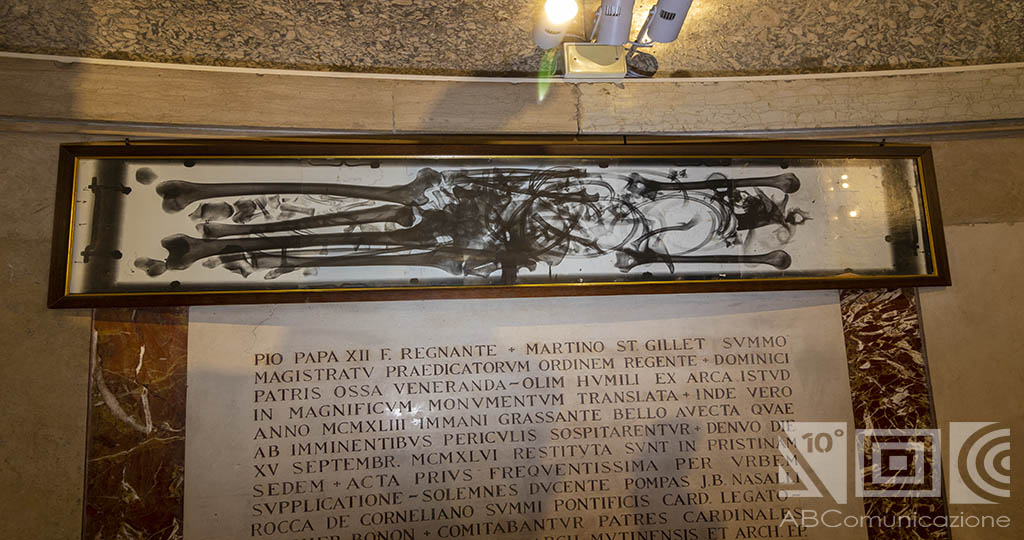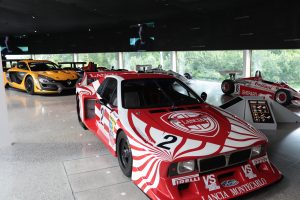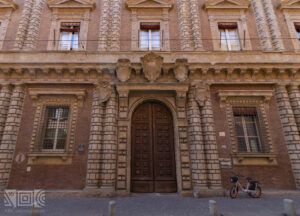Bologna with its thousands of secrets is waiting you! one of those can be found in San Domenico’s church, near the principal Basilica of the city: San Petronio.
San Domenico has often been overshadow by the big number of Basilicas that are scattered around Bologna, often ending up being forgotten.
However this church jealously guards a very important part of the city’s history that not everyone knows about.
Located exactly behind Piazza Cavour – dedicated to the big bolognese artist Lucio Dalla – inside the church are already preserves St. Domenic’s bones. There’s more, because a unique work of art watches over them: the ark in which none other than the great artist Michelangelo participated in its construction.
An incredible opportunity for arts lover and not only: in the church, just a few steps away from the ark, it is possible to see up close the organ played by Mozart during his journey in the city in the late 1700s. We are not just talking about a sacred place, but a place that preserves history, culture and art.

Come and find out more: the Basilica is located at 13 of Piazza San Domenico.
History of Basilica
Dominic Guzman, a.k.a. St. Dominic, decided to found his order right here in the 13th century. This was his first trip to Bologna and he was immediately fascinated by the richness of the cultural center in front of which he stood, especially the importance of the University.
The Dominicans acquired land owned by the Carbonesi family (from which Via De’ Carbonesi, which connects the area of the Basilica of San Domenico to that of San Francesco, takes its name). The purchase included the entire complex of the convent of San Niccolò delle Vigne, which was rebuilt and enlarged to create the present basilica, and the entire surrounding area where they built their convent.
The choice of this location was dictated by the order’s desire to be close to the life of the city and especially to the students of the University. In fact, the friar, as mentioned above, was fascinated by how many students eager to learn had managed to attract Bologna to him and wanted to be part of it.

Dominic died and was buried right here in 1221. His tomb actually underwent several moves before the ark, containing the remains, was finally placed in the Chapel of San Domenico where it can still be visited today.
His connection with the city was so felt by the citizens that, after his death, several Bolognese nobles expressed the desire to be buried right inside the basilica to feel closer to the saint. Like many other buildings in Bologna, it has been hit by various catastrophes over the years that have scarred, destroyed and rebuilt it, making it what it is today.
The surrounding monastery, on the other hand, has always played a central role in city life over the years. For example, during the years of the sacred inquisition, it was the seat of Bologna’s city inquisition.
Michelangelo’s contribution
The ark is certainly the most important part of the visit to the Basilica; it was designed by Niccolo da Bari, later nicknamed Niccolo dell’Arca. Great artists of the time collaborated on its construction, including none other than Michelangelo Buonarroti: it was a young Michelangelo, who had not yet become the artist we all know today, who carved the right-hand candle-holding angel, St. Proculus and St. Petronius into the ark.

This great occasion was the result of several fortuitous coincidences: Niccolò dell’Arca died, leaving his work unfinished at the same time that Michelangelo was forced to flee to Bologna because of some political disagreements in his city.
Usually to see a work by Michelangelo, such as the Pieta, one has to queue for hours and then cannot even get close at all. But not in Bologna: here Michelangelo’s statues are jealously guarded in their privacy. There are no lines of tourists and many do not even know of their existence. This allows few to have an exciting and unique experience. One only has to pass through the gates to get a very close look at every tiny detail carved into the marble, every vein, every fold of the robes, and every little facial expression.
The narrative of the Ark
Going more into the details of the Ark, first of all it should be said that along with the statues made by Michelangelo, at the base there are 6 others representing respectively St. Francis, St. Dominic, St. Florian, St. Agricola, St. John the Baptist and St. Vitale, who together with St. Petronius and St. Proculus are the 8 patron saints of Bologna. For the more observant, the main streets and squares of the city bear their very names.

The protruding upper marble part (cimasa) extends majestically above the sarcophagus proper; it is on the latter, however, that a narrative unfolds in different scenes along the 4 sides:
On the right is a narrative of an event that took place precisely in Bologna, the scene of the so-called miracle of the loaves: one day as Dominic and his brothers were preparing to set the table, they found that they were without bread; the saint, however, told his brothers not to worry and to set the table. Once they were at the table, they all began to pray together, and shortly afterward some good-looking young men appeared carrying bread of their own. They were angels who had responded to the friars’ supplication.
On the opposite side is the scene of St. Peter and Paul handing over their mission to the Dominicans.
On the back of the sarcophagus is depicted the accession of Reginaldo D’Orleans to the order.
The front of the sarcophagus, on the other hand, is divided into 3 scenes: in the center is a depiction of the Madonna and Child and Christ the Redeemer; on the left is the miracle according to which St. Dominic managed to resurrect Napoleon Orsini after a ruinous fall from a horse that cost him his life; and finally on the right is the so-called trial by fire: St. Dominic and some heretics had to show that their word was true, and to do so they began to throw the books of their orders into the fire. If the word was indeed true these would not be burned. Thus it was that the only books that did not burn were those of St. Dominic, proving that he spoke the truth.
The bones of St. Dominic
At the rear of the marble monument is a glass case, dividing visitors from a beautifully decorated structure containing the remains of St. Dominic’s skull. If you are easily impressed, it is strongly discouraged to walk around the ark to avoid the image of an actual skeleton.

Under the skull it is normal to see many pieces of paper that make up a carpet, an honorific. These are notes written by the faithful addressing the saint directly with a prayer, a request for help, or simply praise. Very often they are written in the moment, by the faithful but also by ordinary people who are inspired by their proximity to the relics, as if invaded by a sacred warmth.

The relationship with the saint is not limited to this; one only has to turn around with one’s back to the Ark to see that on the wall in front of the reliquary is displayed an authentic X-ray of St. Dominic’s bones, made by the Institute of Radiology of the University of Bologna.
The Library
We know that St. Dominic was very close to the University of Bologna and admired its work. He, too, wanted to make his contribution to the formation of young minds and did so by building in 1218, inside the convent, a library that was to become a religious, intellectual and cultural reference point for all students. Anyone who had a desire to learn new things could have access to the great knowledge contained in his collection of volumes.
A collection that, thanks to the contributions of professors and monks, grew larger and larger until, by 1400 AD, it was. , the most important library in Bologna.

Today it has more than 200,000 volumes, including rare and valuable manuscripts.
Inside is still preserved the Codex of San Domenico, which dates back to 1200 AD and consists of several parts, including the full text of the Bible.
This library is an enchanting place rich in history that definitely deserves to be a stop on your visit.
The Cloister
Having reached the end of your visit, you cannot forget to visit the Cloister of San Domenico also known as the Cloister of the Dead. It is the last jewel with which to end the journey inside the Basilica. The advice is to visit it in spring, with the arrival of the first warm weather so that you can enjoy the warm atmosphere of the cloister, completely immersed in the wonderful little gardens well cared for by the monks.
It is a breathtaking sight especially at the moment when the last lights of the day hit the walls of the Basilica, just before it closes to the public.
Standing in the center of the garden, one can see all 4 sides of the church: the Gothic-Romanesque bell tower overlooking the Ludovisi Chapel, the dormitory walls and further south those of the library. To end it all with the chapel of St. Dominic. This time seen from the outside.

Don’t waste time wandering around the basilica desperately looking for the entrance. It is not clearly visible. I therefore recommend turning to the monk on duty who is in a small booth on the left side of the nave. If you are lucky he will accompany you himself on the visit, telling you many anecdotes about the history of this holy place.
This is a unique experience even for the less religious. The emotional and cultural importance of this corner definitely surpasses the religious one. Although as soon as you set your feet on the stone paths of the cloister, you immediately feel a very powerful sacred aura.
What to see near the Basilica of San Domenico
Just a few meters from the Basilica you can visit the most striking and famous places in Bologna, such as the beautiful Piazza Maggiore, which serves as a backdrop to the imposing Basilica of San Petronio.
Take advantage of this to visit the mysterious interior of the Basilica or to take a nice photo in front of the uniquely beautiful long white staircase. Bolognese legend has it that in its initial plans, San Petronio was to surpass Milan Cathedral in beauty.
Do not miss this opportunity, but if you are tired after spending a day of culture, there is nothing better than a nice “aperitivo”, in this regard here are our ideas for a delicious italian aperitivo.
If Bologna managed to make a monk fall in love, let its history and beauty overwhelm your heart.
General Information
Before we leave you here is some useful information about visiting San Domenico:
admission is free
The Basilica is open to visitors Monday through Saturday: 9 a.m. to 12 p.m.; 3:30 p.m. to 6 p.m.; and Sunday: 3:30 p.m. to 5 p.m. Hours may vary on holidays and when religious services are celebrated.
Instead, it is possible to attend mass Monday through Friday at: 7:30 am, 12:30 pm, 7 pm. On Sundays, however: 9:00 a.m., 10:30 a.m., 12:00 p.m., 6:00 p.m., 10:00 p.m.
While from mid-April onward, every Tuesday until August 4, Mass times vary in preparation for the celebration of the Saint. These are known as St. Dominic’s Tuesdays.
A final curiosity concerns the very day on which the saint is celebrated; Bologna is the only city where the date of the feast is set for August 4, while everywhere else he is celebrated on August 8, the 4th being dedicated to the Curé d’Ars. The Emilian city, however, is extremely attached to St. Dominic, who is its secondary patron saint, and so it was decided not to change the date.
Bibliography
- Fini M., Bologna sacra. Tutte le chiese in due millenni di storia, Bologna, Editore Pendragon, 2007.
- Venturino Alce, La basilica di S. Domenico in Bologna, Bologna, ESD-Edizioni Studio Domenicano, 1997.
- Guido Zucchini, La cappella dell’Arca nella chiesa di S. Domenico di Bologna dal 1377 al 1597. Continuazione e fine, in: “L’Archiginnasio”, 32 (1937), pp. 236-253




